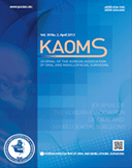Journal of the Korean Association of Oral and Maxillofacial Surgeons
- P-ISSN2234-7550
- E-ISSN2234-5930
- SCOPUS, KCI, ESCI
 ISSN : 2234-7550
ISSN : 2234-7550
A retrospective analysis of mandibular fractures in Mewat, India
Amita Sharma (SHKM Government Medical College)
Rajiv Tanwar (SHKM Government Medical College)
Meenu Dhiman (SHKM Government Medical College)
Radhey Shyam (Post Graduate Institute of Dental Sciences, Rohtak)
Depinder Kaur (SHKM Government Medical College)
Abstract
Objectives: Mandibular fractures vary significantly with respect to epidemiological and demographic parameters among populations. To date, no study has evaluated these aspects of mandibular fractures in Nuh, Mewat, Haryana, India. To retrospectively analyze the incidence, age and sex distri-butions, etiology, anatomic distribution, occlusal status, treatment modality provided, and their correlation in patients who suffered isolated mandibular fractures. Materials and Methods: The records of maxillofacial injury patients who reported to the Department of Dentistry, SHKM Government Medical College from January 2013 to December 2019, were retrieved from our database, and necessary information was collected. The data collected were analyzed statistically using IBM SPSS ver. 21. Results: Totals of 146 patients and 211 fractures were analyzed. There were 127 males and 19 females with an age range of 3-70 years (mean age, 26 years). Road traffic accident (RTA) was the most common cause of fracture (64.4%), followed by fall (19.9%), assault (15.1%), and sports injury (0.7%). Of all patients, 42.5% had bilateral fractures, 31.5% had left side fracture, 21.2% had right side fracture, 3.4% sustained midline symphyseal fracture, and 1.4% had symphyseal fracture along one side of the mandible. Site distribution was as follows: parasymphysis (34.6%), angle (23.7%), condyle (20.4%), body (12.8%), symphysis (4.3%), ramus 2.4%, and dentoalveolar 1.9%. The most common facture combination was angle with parasymphy-sis (17.8%). Occlusion was disrupted in 69.2% patients. Closed reduction was the predominant treatment modality. Conclusion: The data obtained from retrospective analyses of maxillofacial trauma increase the understanding of variables and their outcomes among populations. The results of the present study are comparable to those of the literature in some aspects and different in others.
- keywords
- Mandibular fractures, Mewat India, Etiology, Retrospective study, Incidence
- 다운로드 수
- 조회수
- 0KCI 피인용수
- 0WOS 피인용수